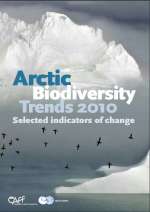 Rapid Changes are taking place in Arctic Flora and Fauna. Unique Arctic habitats e.g. sea ice, tundra, etc are disappearing and some Arctic species have shown a decline. Rapid Changes are taking place in Arctic Flora and Fauna. Unique Arctic habitats e.g. sea ice, tundra, etc are disappearing and some Arctic species have shown a decline.
These statements are examples on the key finding presented in ‘The Arctic Biodiversity Trends – 2010: Selected Indicators of Change’, a new report synthesizing scientific findings on the status and trends for selected biodiversity in the Arctic issued by CAFF
Rapid Changes for Arctic Flora and Fauna Unique Arctic habitats for flora and fauna, including sea ice, tundra, lakes, and peatlands have been disappearing over recent decades, and some characteristic Arctic species have shown a decline. The changes in Arctic Biodiversity have global repercussions and are further creating challenges for people living in the Arctic.
The above statements are examples on the key findings describing changes in Arctic biodiversity that is presented in ‘The Arctic Biodiversity Trends – 2010: Selected Indicators of Change’, a new report synthesizing scientific findings on the status and trends for selected biodiversity in the Arctic issued by the Conservation of Arctic Flora and Fauna (CAFF) Working Group under the Arctic Council.
ARCTIC BIODIVERSITY – AFFECTED BY MULTIPLE STRESSORSThe Arctic Biodiversity Trends 2010 Report, produced by some of the world’s leading experts of Arctic ecosystems and biodiversity, is the Arctic Council’s contribution to the United Nations International Year of Biodiversity in 2010 and will be a preliminary product under the Arctic Council project ‘Arctic Biodiversity Assessment’ (ABA).
In 2008, the United Nations Environment Program passed a resolution expressing ‘extreme concern’ over the impacts of climate change on Arctic indigenous peoples, other communities, and biodiversity. It highlighted the potentially significant consequences of changes in the Arctic. The Arctic Biodiversity Trends – 2010: Selected Indicators of Change report indicates that some of those anticipated impacts on Arctic biodiversity are already occurring.
The report is based on twenty-two indicators and provides a snapshot of the trends being observed in Arctic biodiversity today. The polar bear is one of the most well-known species impacted by changes in the Arctic, but it is not the only one. The indicators show that the Arctic has changed dramatically during recent decades and that unique Arctic habitats for flora and fauna are disappearing. Furthermore, some species of importance to Arctic people or species of global attention are declining.
The report presents a broad spectrum of changes in the Arctic ecosystems and biodiversity.
|
No comments:
Post a Comment